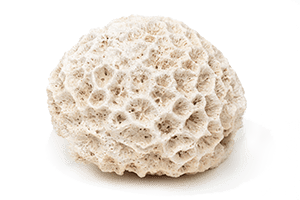Boron has long been known to be essential in plants, but was established as an essential mineral for humans in 1990 (Berger); and is now recognized as an essential trace minerals in plants where it provides benefits involved in a number of important metabolic functions. Boron occurs in sea water at the infinitesimal level of 4,600 ppb, and in the stony coral samples tested at 0.182 ppm. Its exact role in the body is unknown; however, recent experimental evidence suggests boron may be essential for energy utilization and the development and maintenance of bone. There is no RDA for boron. (Halstead)
There is some evidence that boron has trace minerals benefits such as estrogenic activity according to study conducted by the U.S. Dept. of Agriculture. When women on estrogen therapy supplemented their normally low-boron diet, with 3 mg of boron, their blood levels of estrogen, specifically B-estradiol, were significantly elevated. It appears that boron enhances and mimics some effects of estrogen. Food sources of boron are found in such foods as apples, grapes, almonds, legumes, honey, and dark green leafy vegetables such as kales and beet greens. Unfortunately, most Americans are deficient in this forgotten mineral. (Lark and Richards)
Boron is crucial in the absorption of calcium and magnesium, but in post-menopausal women, boron’s effect can boost estrogen and testosterone levels through reduction of the loss of these hormones in the urine. These activities, amongst others, means that boron is at least one actively important nutritional factor in the prevention and treatment of osteoporosis. . . . In fact, if a person is low on boron, they are more likely to be losing calcium, no matter how much milk, dairy products and calcium supplements they are taking. (Thomas)
Paul Bergner, The Healing Power of Minerals, pages 95-98.
Bruce W. Halstead, Fossil Stony Coral Minerals, page 66.
Susan M. Lark and James A. Richards, The Chemistry of Success, page 665.
Lalitha Thomas,10 Essential Foods, pages 78-79, ff.
